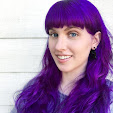My way of coping with the ocean of tools and options is learning them as I need them. Sometimes I'm not even aware certain tools exist until I google "How do I do X in Illustrator?" When you're starting out, you simply do not know what you do not know. With that being said, I'd like to share some of my favorite tips and tricks that I wished I'd known from the start. These knowledge nuggets are all things that I never saw on common lists of "10 Awesome Illustrator Tips," which is why I think makes them even more important to talk about.
As a note, I will be giving a brief overview of the tool and providing links to tutorials from Adobe and other sites. No need to reinvent the wheel.
1) Recolor Artwork
 |
| Recolor Artwork dialog box |
 |
| Going from grayscale to color |
Click here to learn about color groups and the Recolor Artwork tool at Adobe's website. This is also one a great tool to just play around with!
2) Smart Guides
Navigate to View > Smart Guides (or click CMD/CTRL + U), and make sure this option is checked any time you are doing something where placement and alignment are important. I keep them on most of the time to make sure things my elements are in alignment with one another.
Vectips has a good article on smart guides. Here's the Adobe guide.
3) Keyboard Increments
When working on repeating patterns or quilt designs, I frequently change my keyboard increments (Edit > Preferences or click CMD/CTRL + K). That way, if I click a directional key on my keyboard once, I can move an element precisely. Note: holding Shift while you click a directional key will move the object 10 x [keyboard increment].
4) Doing Math in Your Coordinates
 |
| Use the X, Y, width, and height fields to relocate/scale objects |
When you have an object selected, you will see four fields: X, Y, W, and H. These refer to your X and Y axis, and your width and height. The symbol located just before the "X" shows what part of of the object is being used as your reference point. By default, the center should be selected.
You can do basic math (addition, subtraction, multiplication, and division) in these fields. So if you see that the current X value is 6 inches and you want to move your object 4 inches to the right, type "+4" at the end of the "6 in" in the X field. To move to the left, just subtract. Same goes for the Y axis. You could also just type the desired value in all together.
Here is a basic tutorial on how to make a repeating pattern by using these fields.
5) Blob Brush + Eraser
While I love the precision of paths with the pen tool, sometimes I prefer the more natural, organic look of sketches. For the longest time, I thought I would have to "fake" that sketchy look with tutorials like this. Then, I stumbled upon the blob brush tool (Shift + B).
It works just like your average Photoshop (or even MS Paint) brush, but it creates a path for the shapes you draw. It differs from the pencil tool (N) in that it uses a fill, not a stroke. Additionally, you can change the blob brush settings so that any overlapping strokes of the same color will be merged into one shape. Combined with the eraser tool (Shift + E), the blob brush serves as a quick way to achieve natural-looking (and feeling) effects.
As always, Tuts+ has a nice tutorial on the blob brush.
 |
| I used the blob brush to do most of the shading on my moon bunny |




No comments :
Post a Comment